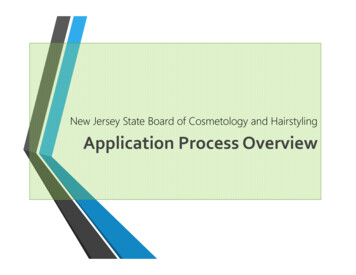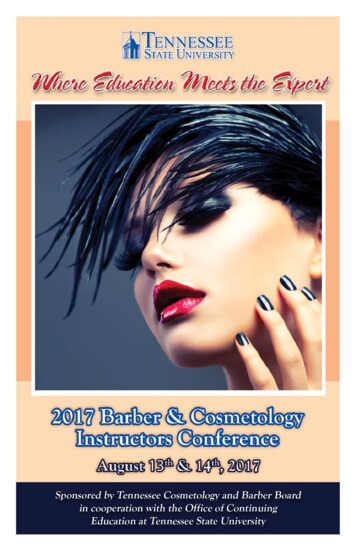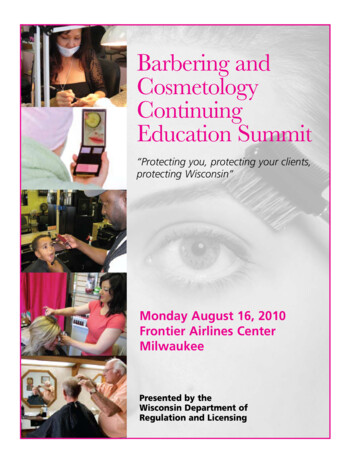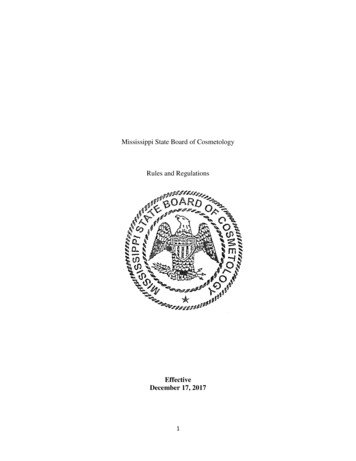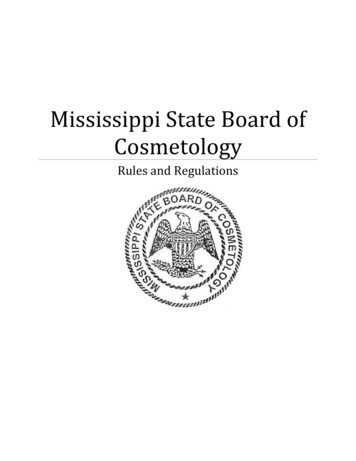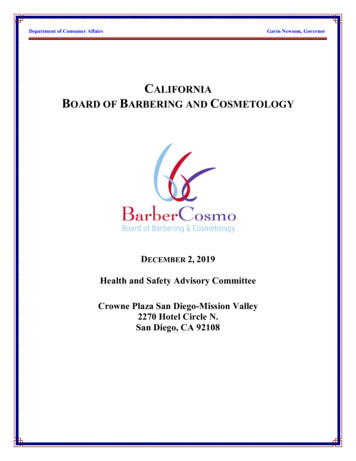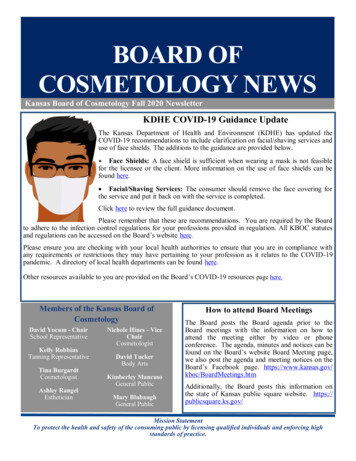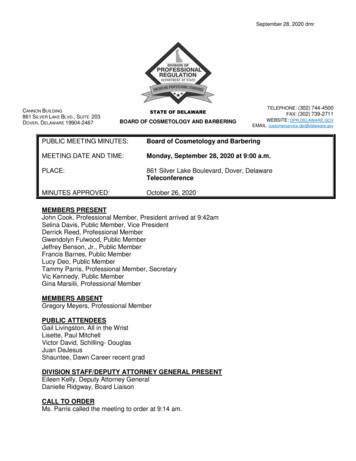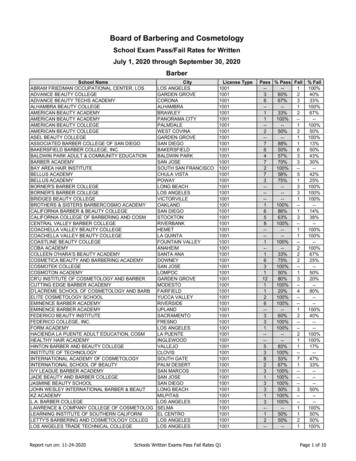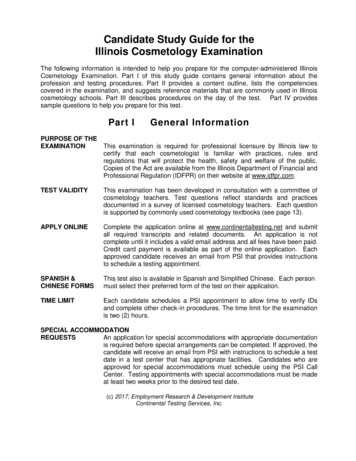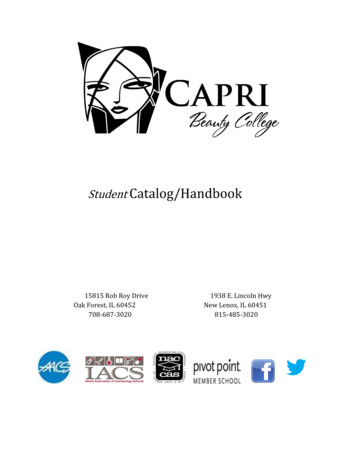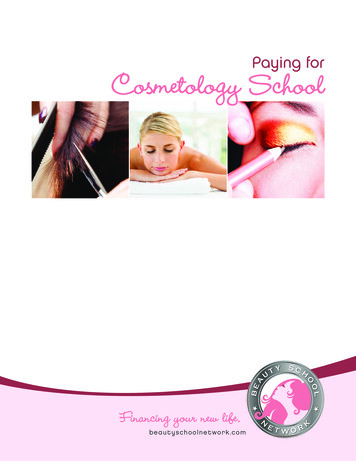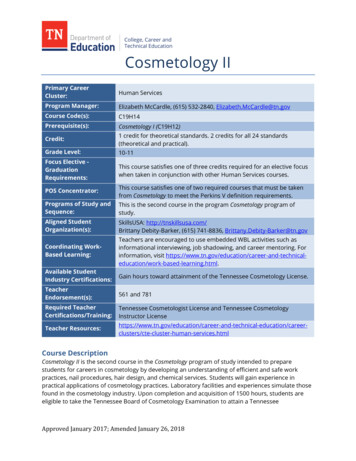
Transcription
Cosmetology IIPrimary CareerCluster:Human ServicesProgram Manager:Elizabeth McCardle, (615) 532-2840, Elizabeth.McCardle@tn.govCourse Code(s):C19H14Prerequisite(s):Cosmetology I (C19H12)Credit:1 credit for theoretical standards. 2 credits for all 24 standards(theoretical and practical).Grade Level:10-11Focus Elective GraduationRequirements:This course satisfies one of three credits required for an elective focuswhen taken in conjunction with other Human Services courses.POS Concentrator:This course satisfies one of two required courses that must be takenfrom Cosmetology to meet the Perkins V definition requirements.Programs of Study andSequence:This is the second course in the program Cosmetology program ofstudy.Aligned StudentOrganization(s):SkillsUSA: http://tnskillsusa.com/Brittany Debity-Barker, (615) 741-8836, Brittany.Debity-Barker@tn.govCoordinating WorkBased Learning:Teachers are encouraged to use embedded WBL activities such asinformational interviewing, job shadowing, and career mentoring. Forinformation, visit ducation/work-based-learning.html.Available StudentIndustry Certifications:Gain hours toward attainment of the Tennessee Cosmetology License.TeacherEndorsement(s):561 and 781Required TeacherCertifications/Training:Tennessee Cosmetologist License and Tennessee CosmetologyInstructor LicenseTeacher an-services.htmlCourse DescriptionCosmetology II is the second course in the Cosmetology program of study intended to preparestudents for careers in cosmetology by developing an understanding of efficient and safe workpractices, nail procedures, hair design, and chemical services. Students will gain experience inpractical applications of cosmetology practices. Laboratory facilities and experiences simulate thosefound in the cosmetology industry. Upon completion and acquisition of 1500 hours, students areeligible to take the Tennessee Board of Cosmetology Examination to attain a TennesseeApproved January 2017; Amended January 26, 2018
Cosmetology License. Artifacts will be created for inclusion in a portfolio, which will continuethroughout the full sequence of courses.Program of Study ApplicationThis is the second course in the Cosmetology program of study. Flexibility is built in to offer thiscourse for either one or two credits, depending on school capacity and early postsecondaryopportunities (i.e., dual enrollment or dual credit). For more information on the benefits andrequirements of implementing these programs in full, please visit the Human Services website ces.html.Recommended CreditIf offering Cosmetology II for 1 credit, follow Option A (theoretical standards). If the offering thecourse for 2 credits, follow Option B (theoretical and practical standards). If all standards in thecourse are covered, the course is recommended for two credits.1 Credit – Option AContentCosmetology CareerReadinessSafety, Sanitation, &Efficient Work PracticesNail ProceduresProperties & Procedurefor HairChemical ServicesStandards1, 2, 34, 5, 67, 810, 12, 13, 1416, 17, 18, 19,20, 21, 22, 23, 242 Credits – Option BCreditCosmetology CareerReadinessSafety, Sanitation, &Efficient Work PracticesNail ProceduresProperties & Procedurefor HairChemical ServicesStandards1, 2, 34, 5, 67, 8, 910, 11, 12, 13,14, 1516, 17, 18, 19,20, 21, 22, 23, 24Course StandardsCosmetology Career Readiness1.) Collect Codes of Ethics from various cosmetology-related professional organizations andexamine areas of commonality. Debate the significance of including standards in theseareas. Synthesize principles from the codes investigated to create a personal code of ethics.Clearly define how the code of ethics relates to the culture of a salon and to retaining clients.Explore different salon cultures possible within the cosmetology industry.2.) Research and demonstrate proper consultation of clients. Practice effective verbal,nonverbal, written, and electronic communication skills for working with clients whiledemonstrating the ability to: empathize, motivate, listen attentively, speak courteously andrespectfully, defuse client's anger or skepticism, resolve conflicting interests, and respond toclient objections or complaints to the client's satisfaction. Using simulations, practiceproblematic clients and consultations using laws as reasoning.Page 2
3.) Research apprenticeships and postsecondary institutions (colleges of applied technology,community colleges, and four-year universities) in Tennessee and other states that offercosmetology-related programs. Evaluate each license that is attainable in the cosmetologyfield. Write an informative paper or develop an infographic identifying entry requirementsfor a specific apprenticeship or postsecondary program of study, and the secondary coursesthat will prepare students to be successful in the program.Safety, Sanitation, and Efficient Work Practices4.) Compile, practice, and critique procedures for maintaining a safe and sanitary environmentfor clients present in a cosmetology facility. Cite information for the Occupational Safety andHealth Administration (OSHA), Environmental Protection Agency (EPA) guidelines, and stateand national code requirements to identify precautionary guidelines to prevent illness,communicable diseases and injuries. Incorporate safety procedures and complete a safetytest with 100 percent accuracy; include exam in course portfolio.5.) Demonstrate and explain the rationale behind each of the following concepts:a. Proper set-up and operation of equipment and utilization of materials by mixingchemicals in appropriate proportions according to manufacturer’s instructions.b. Clean and maintain implements by using appropriately mixed chemicals andfollowing the procedures for decontamination of tools.c. Identify appropriate chemicals and perform disinfecting procedures.6.) Summarize the different functions, structures, and diseases and disorders of hair, skin andnails, citing your sources. Write a script and create a video or public service announcementexplaining how to properly care for hair, skin, and nails through cleanliness, nutrition, andhealthful living. Include correct demonstration of draping, shampooing, conditioning, andrinsing as it applies to safety or diagnosis of the clients in the video or public serviceannouncement.Nail Procedures7.) Research and create an informational artifact (e.g., brochure, poster, fact sheet, narrative, orpresentation) explaining safety and sanitary procedures for nails in manicures and pedicuresas it applies to advanced techniques, cite your sources. Apply nail wraps using propertechniques and safety and sanitary procedures.8.) Write a narrative analyzing the correct removal application for each nail service or pedicureservice technique. Demonstrate proper removal of all materials. Using correct techniques toapply nail tips including all sanitary and safety procedures and chemical processes.9.) Evaluate concepts related to the advanced artificial nail techniques to demonstrate thefollowing while adhering to all manufacturer’s directions and safety procedures:a. Correctly apply artificial material, acrylic and gels, to the free edge of the natural nailand or to the full natural nail. Recognize and demonstrate understanding of diseasesand disorders of the nail as well as the relationship to size for molding the artificialnail into a natural looking nail.Page 3
b. Demonstrate comprehension of acetone product reactions to the skin and nails byremoving the artificial material from the natural nail plate without damage to thenatural nail.c. Apply knowledge of the chemical reactions of products to the skin and nails,correctly demonstrate the ability to properly polish the nail with a base, color andtopcoat to make a smooth even shade to the nail, relying on consultation with client.Demonstrate ability to create an artful scene on a minute surface.d. Exhibit awareness of nail diseases and disorders by providing client with the properinformation regarding safe nail maintenance.Properties and Procedures for Hair10.) Differentiate and demonstrate the proper techniques used in scalp care, shampooing,conditioning, and draping including head massage and specialized treatments, hairbrushing, shampoo and conditioning services, and sectioning.11.) Identify, describe, and effectively demonstrate hairstyling techniques and manipulatingimplements appropriately, include the following, but not limited to:a. Advanced thermal hairstylingb. Advanced braidingc. Formal hairstyling12.) Incorporating geometric principles, identify the reference points on the head, analyzing thepurpose of and interrelationships to their role in haircutting and explaining the importanceof balance, consistency, and necessary technique changes.13.) Research and describe the principles and techniques that guide haircutting, including areasof the head, lines, sections, angles, elevation, guidelines, and overdirection. Apply thehaircutting principles to conduct an effective client consultation while also incorporating ahair and face shape analysis.14.) Draw on cosmetology texts and other technical documents to compare and contrast types ofhaircutting implements. Create a written report or visual depiction outlining the implements’characteristics and properties of each type. Describe the costs and other factors thatinfluence the decision to use each type of implement. Discuss the importance of high-qualityprofessional implements, proper fit, and maintenance that is required of each. List ofimplements may include, but are not limited to the following:a. Haircutting shearsb. Texturizing shearsc. Razorsd. Clipperse. Trimmersf. Sectioning clipsg. Combs: wide-tooth, tail, barber, and styling or cuttingPage 4
15.) Demonstrate good posture and body positions while beginning basic haircutting techniques.Write a narrative explaining the importance of good posture and body positions whilecutting hair, analyzing the long term effects. Haircutting techniques may include:a. Sectioning techniques in relation to bone structureb. Elevationc. Holding shears and comb procedures (combing and actual cutting process)d. Parting techniquese. Sectioning techniques for different haircuts and bone structuresChemical Services16.) Differentiate between the chemical texture services exploring how each service affects thestructure of the hair. Write an essay explaining the importance of potential hydrogen (pH) inchemical texture services, include distinguishing factors between sulfur, hydrogen, anddisulfide bonds.17.) Research various texts and form a hypothesis explaining why clients choose to use chemicaltexture services and how a cosmetologist can influence a client’s decision. Also include atheory on why chemical services are the most lucrative and repetitive services in salons.18.) Prepare informational artifacts (e.g., brochure, poster, fact sheet, narrative, or presentation)of the following chemical texture service topics:a. Indicate and explain the four chemical reactions that take place during permanentwaving.b. Compare and contrast an alkaline wave and a true acid wave.c. Explain the purpose of neutralization in permanent waving.d. Analyze how thio relaxers straighten the hair.e. Describe how hydroxide relaxers straighten the hair.f. Explain curl re-forming and how it restructures the hair.19.) Create an illustrative guide that outlines permanent waving procedures. Include discussionfor the purpose of the preliminary test curls, types of rods, end papers, directions forsectioning a perm, base placement and base direction, wrapping techniques and patterns,and safety precautions for permanent waving.20.) Create a flyer or graphic illustration that demonstrates reasons for why people color theirhair (i.e., covering gray, enhance haircuts, conceal face shape imperfections, trends, etc.).Research and develop a logical explanation of the importance of why learning what specificchemical ingredients are and how they work.21.) Recall and indicate hair characteristics; discuss the importance of evaluating how productsaffect the hair and how to select the best choices for clients. Analyze and identify levels andtheir role in formulating hair color in relation to melanin.22.) Analyze the color wheel and apply concepts of color theory to the development of haircolor.Identify techniques that achieve desired hues, values, and intensities. Demonstrate theability to color mix in various color systems, including color corrections.Page 5
23.) Research and prepare informational artifacts that provide haircolor classifications and theiruses, employing accurate terms and illustrations. Indicate each classification as nonoxidative or oxidative. Provide discussion on natural and metallic haircolor as well as allhaircoloring safety precautions. Classifications should include:a. Temporary haircolorb. Semipermanent haircolorc. Demipermanent haircolord. Permanent haircolor24.) Evaluate chemicals used in the hair coloring process including developers and lighteners.a. Explain the role of hydrogen peroxide in haircolor formulas.b. Compare and contrast lightener processes.The following artifacts will reside in the student’s portfolio: Code of Ethics EPSO & Postsecondary Informational Artifact Safety Exam Nail Safety & Sanitation Artifact Hair Design Procedural GraphicsHaircutting & Styling Implements ArtifactPosture and Body Positions NarrativepH EssayChemical Texture Services Client HypothesisChemical Texture Services Informative ArtifactsPermanent Illustrative GuideHaircolor ClassificationsChemical Services Procedural GraphicsStandards Alignment Notes*References to other standards include: P21: Partnership for 21st Century Skills Framework for 21st Century Learningo Note: While not all standards are specifically aligned, teachers will find theframework helpful for setting expectations for student behavior in their classroomand practicing specific career readiness skills.Page 6
Cosmetology II is the second course in the Cosmetology program of study intended to prepare students for careers in cosmetology by developing an understanding of efficient and safe work practices, nail procedures, hair design, and chemical services. Students will gain experience in practical applications of cosmetology practices. Laboratory .
